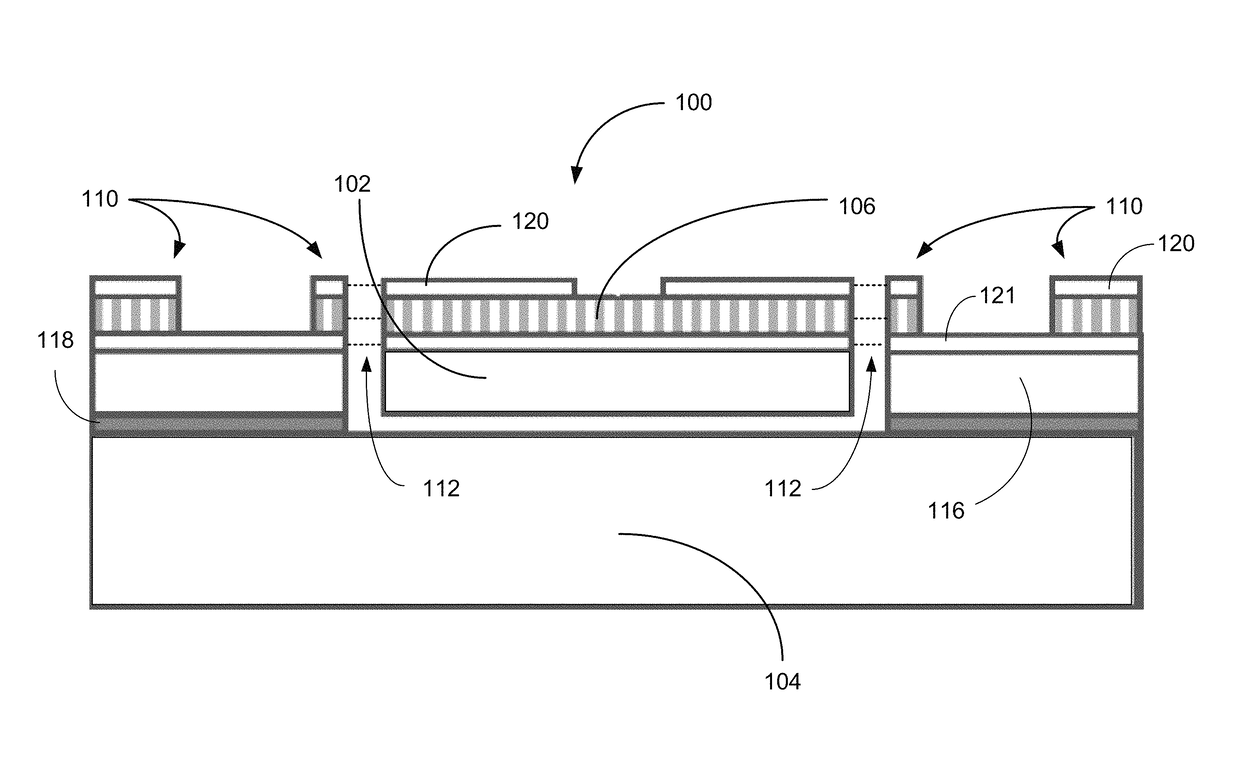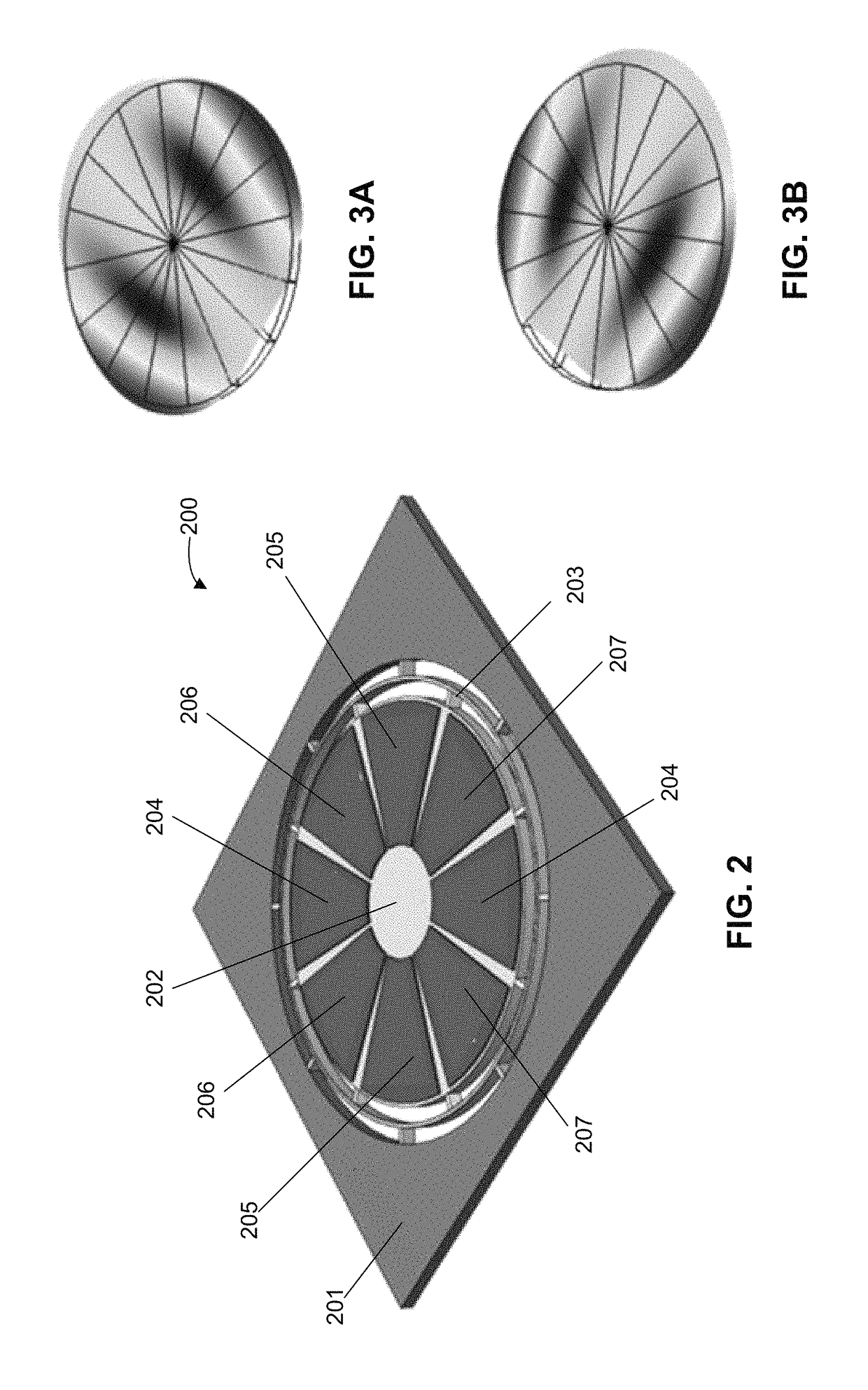Resonant gyroscopes and methods of making and using the same
a gyroscope and high-frequency technology, applied in the field of microelectromechanical systems, can solve the problems of not meeting the performance level demanded by many high-end applications
- Summary
- Abstract
- Description
- Claims
- Application Information
AI Technical Summary
Benefits of technology
Problems solved by technology
Method used
Image
Examples
example 1
[0086]FIG. 9A-C shows the SEM images of a fabricated disk resonator gyroscope in accordance with some embodiments. In this embodiment, a 1-mm-diameter piezoelectrically transduced disk gyroscope comprised of a 1.3-μm thin film of AlN sandwiched between Molybdenum (Mo) electrode layers and stacked upon a 35-μm-thick (100) plate of single-crystal silicon. The bottom Mo electrode is used as the common terminal and the electrically-isolated top Mo electrodes are used for actuation, sensing and tuning of the gyroscope. The device was fabricated using a 4-mask AlN-on-Si process similar to the one described in W. Pan et al., “Thin-film piezoelectric-on-substrate resonators with Q enhancement and TCF reduction,” PROC. MICRO ELECTRO MECHANICAL SYSTEMS (MEMS), 727, 730 (2010).
[0087]In the embodiment depicted in FIGS. 9A-C, the gyroscopic coupling between the two degenerate in-plane flexural modes of a 1-mm-diameter disk structure having a resonance frequency of 4.34 MHz was verified by finite...
example 2
[0092]The gyroscopic coupling between the two orthogonal flexural mode pairs of a square resonator (A0) were modeled using a COMSOL Multiphysics simulation tool for a 300 μm×300×20 μm silicon square resonator having a thin ( direction of a (100) silicon plate. A quality factor (Q) of 3000, obtained from the measured results of a fabricated sample operating in air, was assumed for the resonance modes. The modeled resonator device was actuated by applying a 1.6 V (peak) harmonic signal to the drive electrode, resulting in the antinode displacement of ˜32 nm at the resonance frequency, which in turn induces Coriolis-induced current at the sense electrode when a finite rotation rate is applied.
[0093]FIG. 15 shows the simulated Z-axis rate response of the square gyroscope, resulting in a sensitivity of about 250 pA / ° / s per electrode. A mechanical noise equivalent rotation rate of 0.01 / Vs / A / Hz has been extracted for the square gyroscope operating in linear regime with a drive voltage of 1...
example 3
[0094]FIG. 16 shows the measured frequency response of an example gyroscope device operating in A0 mode (i.e. first flexural mode), observed from the drive input to sense output electrode. The observed frequency split of approximately 10 kHz (<1000 ppm) between the two modes is attributed to process non-idealities.
[0095]FIG. 17 depicts a measured response of an experimental piezoelectric gyroscope device to Z-axis rotation rates, as measured using a rate table and a read-out circuit (similar to the circuit 500 as shown in FIG. 5). In this example, the gyroscope device was excited in its first flexural mode (˜11 MHz) and characterized for different input rotation rates resulting in a sensitivity of 20.38 pV / ° / s for a sinusoidal drive voltage of 1.6 V (peak), which is comparable to capacitive BAW disk micro-gyroscopes with similar resonance frequency and drive / sense modes frequency.
[0096]The measured rate sensitivity is in close agreement with the value extracted from simulation (19.6...
PUM
 Login to View More
Login to View More Abstract
Description
Claims
Application Information
 Login to View More
Login to View More - R&D
- Intellectual Property
- Life Sciences
- Materials
- Tech Scout
- Unparalleled Data Quality
- Higher Quality Content
- 60% Fewer Hallucinations
Browse by: Latest US Patents, China's latest patents, Technical Efficacy Thesaurus, Application Domain, Technology Topic, Popular Technical Reports.
© 2025 PatSnap. All rights reserved.Legal|Privacy policy|Modern Slavery Act Transparency Statement|Sitemap|About US| Contact US: help@patsnap.com



